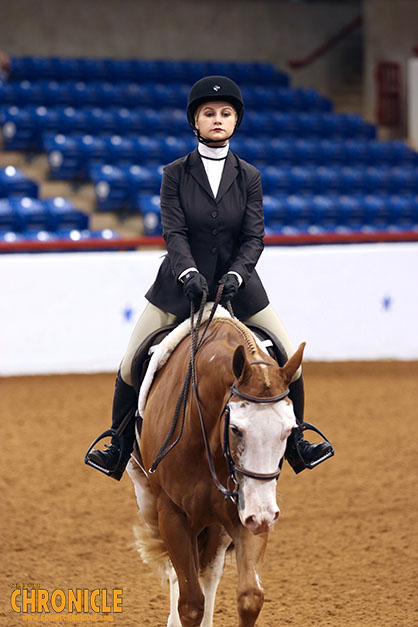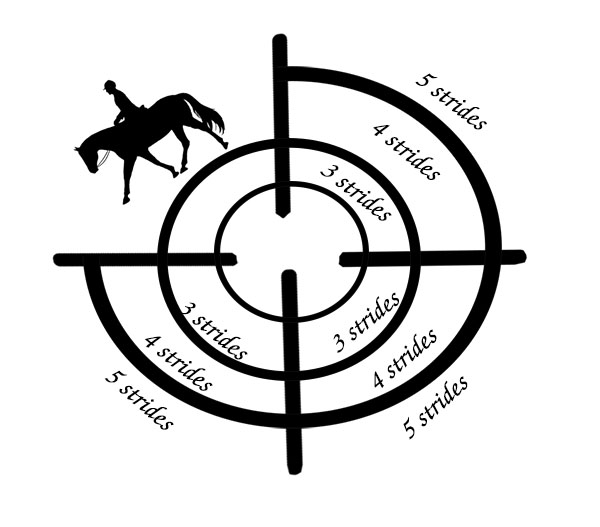COVID- 19 At Home Schooling Survival Guide- Hunt Seat Equitation With Lainie DeBoer

By: Brittany Bevis
When Carson Griggs shared his At Home Trail Schooling Survival Guide last week, our readers loved the fun obstacles and exercises that they could practice at home. That gave us an idea… What if we reached out to a number of top trainers to have them create patterns or exercises especially for our Equine Chronicle readers.
Today, Lainie DeBoer will be walking you through five exercises to help hone your Equitation skills. Up next will be Arturo Maestas with a Horsemanship pattern and Jenny Frid with a Showmanship tutorial. Stay tuned to www.EquineChronicle.com each week for the next pattern/exercise series.
“First and foremost, this is an incredible opportunity to hit the pause button on your showing and really focus on your riding,” Lainie says. “When we study Hunt Seat Equitation and, more importantly, the judging system, your form and effectiveness is very heavily weighted in each maneuver and overall impression. So, now would be a good time to go back to the basics of your position and hone your skills so you can gain as many points as you can.”
Exercise #1- Longing on a Line
“The one exercise I would start out with for developing your position is working without your stirrups and reins. If you can get somebody to longe your horse for you, go back to when you just started riding and be longed without anything but your saddle. It’s a real wake up call. Be aware of how it feels from one direction to the next. Do you lean in? Do you tip over? Then, try to close your eyes and just feel the rhythm of the horse. Some people might think this is remedial, but it’s such a good way to see where your weaknesses are and what you need to work on to strengthen your position.”
 Exercise #2- Circle Swirl
Exercise #2- Circle Swirl
“The second exercise involves swirling in and out of a circle. Put yourself on a 20 meter circle at a posting trot and gradually swirl your circle inward with a counter bend until you reach a circle that’s around 10 meters (half of the original circle). As the circle gets tighter, start to sit the trot and engage your horse’s tempo. Change the bend to an inside bend and then slowly push the circle back out to a 20-meter circle. You can do this at the canter as well. What it’s doing is forcing you not only to engage your horse and balance, but it makes you use all your aids harmoniously to work the horse laterally on a circle. It’s very hard; but, when it’s done correctly, the horse should be listening to your every move.”
Exercise #3- Two Point, Two Point, Two Point!
“This is one of my biggest pet peeves when I judge. I see so many weak two point positions. It’s incredibly important, because the purpose of Hunt Seat Equitation is to develop a rider for Over Fences. Even if you never attempt to jump, the rule of thumb is you should look like you could. The only way to develop a good two point is to repeat it every day in your riding routine. If you can perfect the correct two point, I guarantee you will be scoring some big points across the board in your patterns.”
Exercise #4- Stride Adjustment
“The fourth exercise is really simple but fun. Just put two poles in a straight line as far apart as you want. Canter over both poles in the line and find the number of strides you do between the two poles. Once you have the number, say six strides, start to add and delete strides, like five strides or seven strides. This is going to help you with collection and lengthening. You can play with your two point in the lengthening part as well.”
 Exercise #5- Wheel of Death
Exercise #5- Wheel of Death
“If you have four poles to work with, you can spread them out evenly on a circle. We call this the ‘Wheel of Death.’ Canter the circle and try to fit in the same number of strides between each pole. So, if I do four strides, then I will do that between each pole. The goal is to canter two full circles without the number ever changing. You can take it a little further for added experience to make the circle wider and add a number, or the opposite and make the circle smaller and delete a stride. For example, if you do four strides the first time, then try five strides and then three strides. It’s really a fun exercise, and it challenges your connection with your horse and the quality of your position.”
Click here to watch a video of Lainie performing these exercises.
Remember to stay tuned to www.EquineChronicle.com for Horsemanship and Showmanship coming soon. Also, if you plan to try out any of these exercises, send us a video to share by emailing B.Bevis@EquineChronicle.com.










